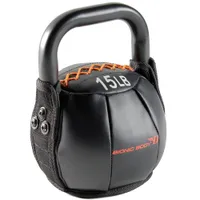'I did 100 kettlebell swings every day for a month - this is what happened'
Our writer took on a kettlebell challenge, doing 100 swings a day for a month - and these were the results...


Welcome to my account of my recent kettlebell challenge! Yes, that's right - another day, another challenge for me (regular readers will hopefully be enjoying my 'my pain for your gain' approach - click on my bio to see more if you don't know what I'm talking about!).
This time I set myself the target of doing 100 kettlebell swings every day for a month. Why 100? Well, it's a nice round number that seemed like it would offer up a decent challenge. And why a month? Well, as with any fitness challenge you take on, it's important to do it over a substantial period of time, in order to actually notice any benefits or drawbacks.
Ok, ok - but why kettlebell swings? Well, as a personal trainer I'm a BIG fan of this dynamic exercise (as you can see from my Instagram video below). That's partly due to the fact that it's a full-body move. Plus, kettlebell swings can really help with posture (I'll go into this in more detail later).
But don't just take my word for it - Ashton Turner, co-founder of London gym Evolve 353, backs up my love of the kettlebell swing.
'It’s a big ‘bang for your buck’, exercise working the glutes, hamstrings, core and upper back, so you get a great workout in one move,' he says.
'Plus by varying rep ranges and the weight of your kettlebell, you can easily train for a variety of goals from strength, to power to fat loss.'
Sounds pretty good, right? Well, I thought so - and so I grabbed my best kettlebell and got stuck in.
Start your week with achievable workout ideas, health tips and wellbeing advice in your inbox.
Read on to find out how I fared when I attempted 100 kettlebell swings a day for a month, along with my top tips on how to do a kettlebell swing if you want to give them a try yourself.
A post shared by - Lucy E Gornall - (@lucyelizabethgornall)
A photo posted by on
My heart rate shot up
I measure my heart rate when I workout on my Apple Watch Series 6, one of the best fitness watches in my opinion. A lot of my high intensity workouts will take my heart rate up to around 183 BPM (beats per minutes), which is just under my max heart rate of 190 (you can roughly work out your own max heart rate by subtracting your age from 220, although factors such as age, fitness levels and general health ae also a factor).
When I did 100 kettlebell swings a day, my heart rate was hitting 150-160 bpm. This surprised me a little as it wasn't a particularly grueling activity, but it did go on for a good few minutes, so my endurance was tested.
There's even a study that confirms how a workout of kettlebell swings leads to a higher heart rate than when doing a circuit workout, which in this instance was based on smith machine squats, bench presses, leg curls, and lat pulldowns.
I felt so many muscles working
As Ashton proclaimed, kettlebell swings really do offer more bang for your workout buck - because I felt them everywhere.
Not only did my glutes feel sore after a month of 100 kettlebell swings a day (more on that next), but my whole back felt like it was pounding too.
As a personal trainer, I often try and incorporate kettlebell swings into clients' exercise programs as they help work what's called the posterior chain, essentially a line of muscles that runs up the back of the body.
'When you think of the posterior chain, think glutes, hamstrings, erector spinae (a group of muscles running up your spine) and lats; essentially the back muscles,' Ashton explains.
He adds that, in our modern world, where we spend most of our time hunched over a phone, laptop and/or desk, 'we end up becoming anterior (front of the body) dominant and weak in our posterior chain'. This can ultimately lead to injury.
The advice? 'To build a balanced, robust, injury proof body, you need to spend as much time (or possibly more time), on your posterior chain. Thankfully the kettlebell swing works the whole posterior chain which is why it’s such a good exercise.'
Bowflex 840 SelectTech Kettlebell | Was $199 | Now $149.11 | Saving $49.89 (25%)
This Bowflex weight could be considered the daddy of all kettlebells - and its currently an absolute steal in the Amazon Prime Day shopping event. With just a turn of a dial you can automatically change the weight resistance from 8 pounds all the way up to 40 pounds - giving you full control of your workouts in a single piece of kit. Plus you can save an extra 20% at checkout when you start a free Prime trail. You'll need to click quick - Prime Day ends midnight on June 22!
Bionic Body Kettlebell (various weights) | From $24.98 | Saving up to 29%
If you can't be doing with high-tech equipment and would prefer to stick with a tried and trusted specific weight, then one of Bionic Body's range of kettlebells could be the deal for you this Prime Day. The weight itself is made from soft materials, to help you avoid injuries or unsightly bruising on those knees. Choose from 10lb, 15lb, 20lb, 25lb and 30lb varieties.
My butt perked up
Thanks to the glutes being one of the main drivers behind a kettlebell swing, it was only natural for me to start feeling the burn in my bottom as I attempted my month-long challenge. It tended to hit at about the 25 mark; after this many swings, my butt started to fire up.
And, by around 20 days into the challenge, I can safely say I felt my bottom was a little perkier. Not quite as perky as when I did my 500 squats a day challenge, perhaps. But, I digress...
My box jumps improved
A post shared by - Lucy E Gornall - (@lucyelizabethgornall)
A photo posted by on
Yup, it's true. I just felt like I had more power coming from my lower body, handy for jumping on high boxes at the gym or - as my photo shows - on park benches. And it turns out that there's some science to explain this power boost.
One research report published in the Journal of Strength and Conditioning Research showed that six weeks of bi-weekly kettlebell training actually improved explosive strength (the type of strength needed for Olympic lifting, gymnastics and - yes - box jumps) by almost 20%.
Meanwhile, another study also found that regular kettlebell swinging led to improvements in maximum and explosive strength.
So it's no surprise that after two weeks, I did begin to notice slight improvements in my box jump height. Olympic high jump record, I'm coming for you!
What's more, as a keen runner and sprinter (you can read about what happened when I tried to run 5k every day for a month, if you like), I definitely noticed more power in my legs when I headed down the local track for my sprint session - which mirrors another study that suggests kettlebell swings can positively impact sprint times.
My hands were left blistered
Who doesn’t want lovely, soft hands? I certainly do, which is why I always carry hand cream around to help keep mine in tip-top condition.
Unfortunately my efforts were in vain over the course of this fortnight, as doing 100 kettlebell swings every day left the palms of my hands in tatters. Hard calluses erupted and I ended up picking at my skin all the time (disgusting, I know).
Handily (as it were), I did find a useful YouTube video though that explained how to get rid of them, which offered some relief - but if you're gonna swing every day, your hands are going to suffer. There's no two way about it!
Kettlebell challenge: my verdict
Look, I'd be lying if I said I would do this for a second month. Why? Well, in all honestly, doing 100 kettlebell swings in a row is actually quite dull. When I plan workout sessions for my clients, I always ensure there's enough variation to keep things interesting - and that was sorely missing during this challenge.
Plus, it's a considerable amount of time spent focused on form. The kettlebell swing requires back and core engagement; it's not a move you can do half heartedly with your eyes closed - at least, not if you want to stay injury free. Doing 100 reps took a lot of concentration, and I can see how it would be easy for this to lapse - which could end badly for my body.
However, I will 100% be including kettlebell swings into my workouts more regularly going forward, as they're a great all-round move, working a variety of muscles and boosting key fitness elements such as power and speed.
But, before I do anymore kettlebell swings, I just need to sort my hands out. EEK!
How to do a kettlebell swings: top tips
There are many variations on kettlebell swings, but for many the one that will come to mind when thinking of this move is a classic Russian swing - here's how to do them.
- Start with your kettlebell in front of you on the ground. Keep feet shoulder-width apart and bend the knees slightly.
- Grab the kettlebell handle with both hands, hinging at the hips, and slightly take the kettlebell back between your legs.
- Thrust your hips forward, and using the momentum from this hip movement, bring the kettlebell up to shoulder height, maintaining just a slight bend in your elbows.
- Keep your back straight throughout and then let the kettlebell fall back between your legs behind you, keeping your core engaged as you do so.
- Ensure that it's your glutes and legs taking the force of the kettlebell and not your arms.
- Repeat the whole movement for as many reps as you're aiming for. Remember to start of small if you're new to the move.
Common kettlebell swings mistakes to avoid
Ashton reveals that there are some common mistakes that people make when doing a kettlebell swing.
A key one is squatting the kettlebell as opposed to hinging the kettlebell. 'This changes it from working the posterior chain to making the move more quad dominant,' he says.
So, as detailed above, really focus on hinging at the hips in order to thrust the kettlebell upwards.
Ashton adds that another mistake people make when doing kettlebell swings is 'over extending at the top of the swing'. This comes from not engaging your core or squeezing your glutes and can result in lower back injuries.
Keep these common errors in mind when you swing, and try to avoid them in order to maximize the move and avoid injury.
Lucy is a freelance journalist specializing in health, fitness and lifestyle. She was previously the Health and Fitness Editor across various women's magazines, including Woman&Home, Woman and Woman’s Own as well as Editor of Feel Good You. She has also previously written for titles including Now, Look, Cosmopolitan, GQ, Red and The Sun.
She lives and breathes all things fitness; working out every morning with a mix of running, weights, boxing and long walks. Lucy is a Level 3 personal trainer and teaches classes at various London studios. Plus, she's pre- and post-natal trained and helps new mums get back into fitness after the birth of their baby. Lucy claims that good sleep, plenty of food and a healthy gut (seriously, it's an obsession) are the key to maintaining energy and exercising efficiently. Saying this, she's partial to many classes of champagne and tequila on the rocks whilst out with her friends.


